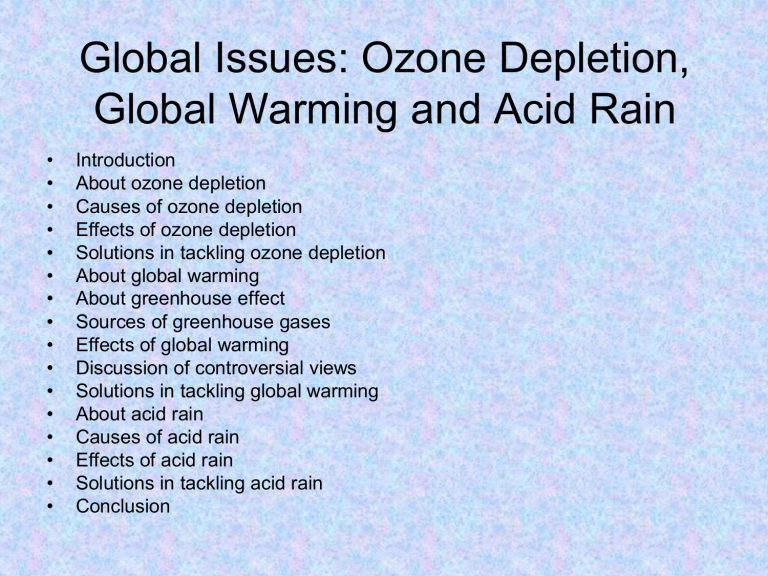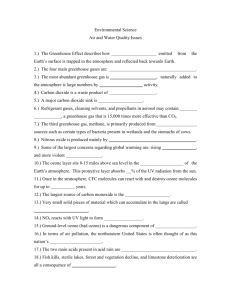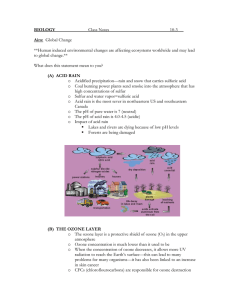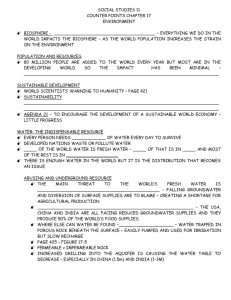Ozone layer depletion
advertisement

Global Issues: Ozone Depletion, Global Warming and Acid Rain • • • • • • • • • • • • • • • • Introduction About ozone depletion Causes of ozone depletion Effects of ozone depletion Solutions in tackling ozone depletion About global warming About greenhouse effect Sources of greenhouse gases Effects of global warming Discussion of controversial views Solutions in tackling global warming About acid rain Causes of acid rain Effects of acid rain Solutions in tackling acid rain Conclusion Introduction Air pollution is exerting increasing impact on the environment. Humans have been altering the chemistry of the atmosphere on a global scale. These changes may: • Modify the global climate • Threaten the health of human beings • Create many environmental problems such as – Acid rain – Depletion of ozone layer – Global warming • Seriously upset the global ecosystem What is ozone depletion? • Ozone is a highly reactive gas comprising triatomic oxygen • Ozone layer in the stratosphere protects the Earth’s surface from UV light • Ozone depletion refers to a lowered concentration of ozone in the upper atmosphere • “Holes” are formed • More UV radiation is reaching the Earth’s surface October ozone levels over Antarctica since the late 1950s. What are the causes of ozone depletion? • Presence of chlorofluorocarbons (CFCs) • Presence of oxides of nitrogen • Presence of halogens • Presence of bromine The radicals would speed up the loss of ozone because they constantly re-emerge to trigger another reaction What are the effects of ozone depletion? • UV radiation is absorbed by DNA and modifies them, affecting the expression of genetic information • A higher incidence of skin cancer,lung diseases and cataract • Reduce the yields of crops • Disruption of the ecological balance in the ocean • A higher incidence of photochemical smog What can we do to solve the problems of ozone depletion? • Reduce emissions of ozone-depleting chemicals • Reduce the uses of aerosol sprays • Use the aerosol sprays that are free of CFC compounds instead What is global warming? • Global warming refers to the gradual increase in the average temperature in the atmosphere • Increase in concentration of greenhouse gases in the atmosphere • The heat loss from the Earth to the Space is slowed down • An enhancement of the greenhouse effect leads to global warming • Greenhouse gases include carbon dioxide, chlorofluorocarbons, methane, nitrous oxides, ozone, water vapour, etc What is greenhouse effect? • Most of the incoming solar radiation is in the visible part of the spectrum • Most visible light passes through the atmosphere without being absorbed • The earth radiates heat back out towards space when warmed up • Much of the radiation does not escape into space • Most is trapped by certain gases in the atmosphere, carbon dioxide and particular water vapour What are the sources of greenhouse gases? • Greenhouse gases are generated by varies human activities, because of • burning of fossil fuels • deforestation • extensive rearing of livestock • extensive use of cooling agents, blowing agents, insulating and packaging materials, aerosol sprays and solvents What are the effects of global warming? • • • • • • • • • • Thermal expansion of the oceans, melting of glacial ice Flooding Low-lying cities would be submerged Global climate would be affected due to the removal of rainforests Distribution of the climatic regions and ocean currents would be changed Increase in frequency and severity of weather extremes Increase in temperature of marine Biodiversity Alter disease pattern, thus, increase the spread of epidemics Pests could become more active and grow faster The trend of global warming is controversial • It is believed that an increase in atmospheric temperature would lead to faster growth of plants and phytoplankton on land and aquatic environments. This would increase the consumption of carbon dioxide in photosynthesis, bringing a re-balance of carbon dioxide in the atmosphere. Plants would transpire faster in the warmer air. The atmosphere would thus become more humid and more advantageous to plant growth. What can we do to solve the problems of global warming? • • • • • • • • Use “cleaner energy” Smart transportation and land use Forestation Watch less TV Use less air conditioner Turn off the light when leaving the room Take public transport Use less microwave oven What is acid rain? • Acid rain refers to precipitation in the form of dilute acid solutions • Not a single phenomenon • The pollutants involved are sulphur dioxide, oxides of nitrogen, ammonia, ozone and various volatile organic vapours • Acid rain typically has a pH from 4.0 to 5.4 What are the causes of acid rain? • Sulpur dioxide reacts with oxygen in air, forming sulphur trioxide • Sulphur trioxide dissolved in rain water to form a dilute solution of sulphuric acid • Sulphur dioxide can also dissolves in rain water directly • Nitrogen dioxide is formed by combining nitrogen monoxide with oxygen • Nitrogen dioxide reacts with water and oxygen to form nitric acid What are the effects of acid rain? • • • • • Damage the buildings, statues Corrode marble and metals Causes human respiratory diseases Increases the acidity of soil Induce the release of aluminium ions from soil particles • Acidify lakes What can we do to solve the problems brought by acid rain? For individuals: Individuals can contribute directly by conserving energy, since energy production causes the largest portion of the acid deposition problem. • Turn off lights, computers, and other appliances when you're not using them • Use energy efficient appliances: lighting, air conditioners, heaters, refrigerators, washing machines, etc. • Only use electric appliances when you need them. • Carpool, use public transportation, or better yet, walk or bicycle whenever possible • Buy vehicles with low NOx emissions, and maintain all vehicles well. For society: • Understand acid deposition's causes and effects • Clean up smokestacks and exhaust pipes • Use alternative energy sources • Restore a damaged environment • Look to the future Reference • http://www.epa.gov/ozone/ • http://www.beyonddiscovery.org/content/vi ew.article.asp?a=73 • http://www.ucsusa.org/global_environment /archive/page.cfm?pageID=551 • http://www.cln.org/themes/ozone.html • http://www.epa.gov/acidrain/site_students/i ndex.html • http://globalwarming.enviroweb.org/ The End 6B Cheung Yee Lin (4), Ching Yi Yan (5)



